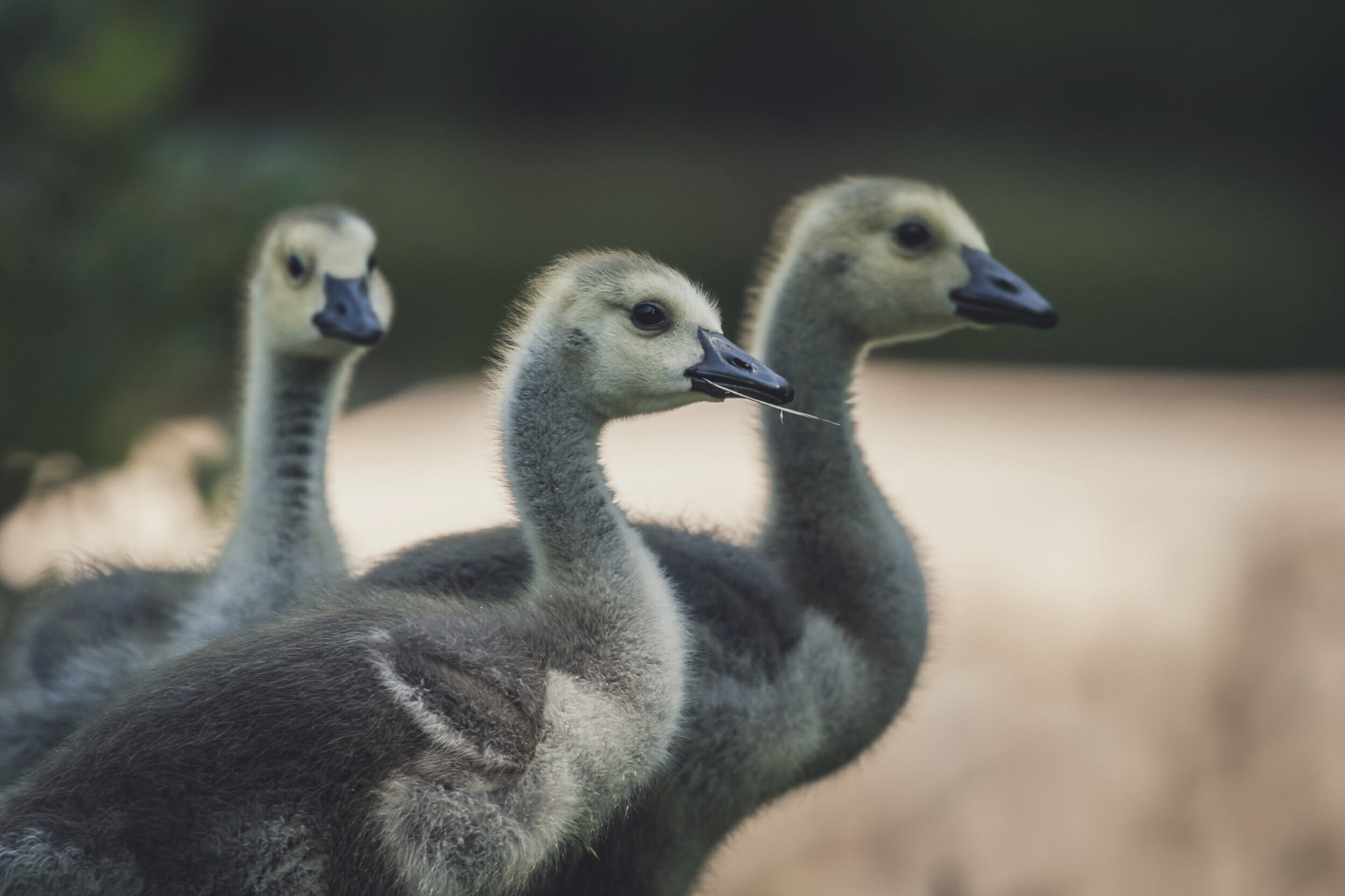
Feather Production
Feathers are used in decorations, crafts, and in manchester and clothing. Perhaps most commonly, down (the fine feathers of various birds) is commonly used in winter jackets, pillows, and doonas. Known as light-weight, breathable, and extremely warm, the use of down is almost seen as essential to winter items, with little thought into where all the feathers come from. Many believe that down is a by-product of the meat industry, but is there any truth to this? In this article, we will explore how the feather industry operates, and its impact on the animals used, the environment, and the people directly or indirectly involved.
The Industry
Across the globe, geese, ducks, ostriches, emus, and turkeys, are exploited for their feathers. Whilst feathers are referred to as a by-product of the meat industry, this claim is misleading to consumers, as some producers in China and Europe practice live-plucking, sometimes multiple times, before the animal is sent to slaughter for meat. China is the world’s largest producer of down, accounting for 80% of global production. As China has no animal welfare standards or laws, most farms conduct live plucking to increase profits [1, 2, 3].
Demand
The different types of feathers are used for a variety of products. Down, the soft, fluffy undercoating that keeps geese and ducks warm, is the most common form of feather demanded and is used as stuffing for jackets, pillows, and doonas or duvets. Finer types from ostriches, are used externally on clothing, such as wedding dresses, coats, and costumes. Detailed feathers from ostriches, emus, and turkeys are often used for decorations or cleaning products. While smaller, “cheaper” quality feathers from turkeys and chicken are most commonly dyed for accessories, toys, or used for arts and craft.
Chicken feathers are also collected, ground up and added to feed for farmed animals [4].
Standards and Welfare Issues
All countries have varying animal welfare standards and issues. The information below will provide a brief explanation of the conditions and issues with farming animals for feathers.
Farming
In most countries, chickens, ducks, geese, and turkeys are farmed under intensive conditions - meaning they are denied their natural behaviours and live in overcrowded conditions amongst their waste.
In Australia, chickens, ducks, and turkeys are legally farmed inside crowded sheds, and can undergo painful beak trimming to negate unnatural behaviours caused by stress. Ducks have the additional issue of being farmed without access to open water - something that is crucial for their health and wellbeing.
To learn more, please read the respective articles chickens, ducks, and turkeys.
Live plucking
While illegal in Australia, ducks, geese, emus, and ostriches can be subjected to live-plucking multiple times in their lives. This is incredibly painful for the animals as each feather is ripped from the follicle where there are pain receptive nerves, leaving their bodies a bloody mess. Once their feathers are ripped out, many of the birds become traumatised and paralysed with fear. Some die as a result of the procedure. Geese can have this done up to six times a year, before being slaughtered [5].
An undercover investigation in China by PETA, shows employees ripping fistfuls of feathers from the shrieking ducks and geese. Their bodies are often left with bloody wounds [6].
European countries have claimed to only practice live plucking when ducks and geese are naturally moulting (losing their feathers) [7] - however, this form of ‘production’ only represents a small portion of the industry.
Credit: Four Paws
Undercover investigation: Live Plucking
While live plucking was previously thought to only happen to geese and ducks, an investigation by PETA in South Africa also showed ostriches having some of their feathers ripped out while they were alive [8].
Credit: United Poultry Concerns
Slaughter
The feather industry is entwined with the meat industry, which means that once the animal’s feather production slows or they reach their slaughter weight, they are killed. Please note, slaughter practices vary for each country.
In Australia, chickens, ducks, and turkeys are transported to the slaughterhouse where they are shackled upside-down by their legs, stunned and have their throats slit. They are then placed in a de-feathering tank and their feathers are collected and sold [9].
Ducks at a Chinese slaughterhouse
Credit: Clover Hu
Other Issues
As with fur, leather, and wool, companies do not have to state where the feathers are sourced from. The lack of transparency makes it impossible to know whether you are supporting or avoiding the live-plucking of animals when purchasing any feather items.
Environmental impacts
Feathers are often presented as a more environmentally friendly option in comparison to faux items – but is this really true?
Resource Use
Chickens, ducks, turkeys, emus and ostriches require an immense amount of resources in the form of food, water, and land. To learn about the resource use of each of these farmed species, please click on the respective article.
Waste
Chicken, duck, turkey, emu, and ostrich manure contains phosphorus, nitrogen and potassium as well as trace elements zinc, manganese and copper [10], and is also a source of ammonia, salts, heavy metals, possibly trace antibiotics [11]. In Australia, the waste litter (faecal, feathers, spilled feed, water, and bedding from the floors of sheds) is collected after the animals have been taken to slaughter. The industry claims that this is often used to fertilise crops, however, the waste produced far exceeds the amount needed for crop production and the soils natural absorption rate. The excess nutrients can also have detrimental impacts on the environment [12]. An international analysis of ostrich farming found that ostrich farms produced more pollutants than chicken farms. Ostrich farms produced 5 times more CH4, 10 times more N2O, 6.8 times more NH3, and 6.5 times H2S than those of the chicken production system [13].
Credit: ACT Sustainably
Health Impacts
Farming animals for their feathers not only affects the animals and the environment, it also impacts humans.
Human Health
Feathers, from all countries, come predominately from factory farms, where thousands of animals are crammed into a small space and live among their waste for weeks on end. As explained in our articles on chicken, duck, turkey, and ostrich and emu farming, these environments create the perfect conditions for the next zoonotic disease. Factory farm animals also consume approximately 80% of the world’s antibiotics. Feeding animals antibiotics has the potential to create antibioitic resistant diseases [14]. Health professionals and scientists believe a new disease from facilities such as these could have a greater impact than the current Coronavirus pandemic, as the disease could jump to wild species, and also be spread through meat products [15].
Did you know that Influenza (the flu) started as an intestinal bug in ducks? The virus sits in their intestinal lining and as they secrete, it enters the water and is consumed by other ducks, spreading the virus. When ducks were mixed with land-based avian species – chickens – the disease infected them, and then mutated to infect humans [16].
Other common disease outbreaks include salmonella, Escherichia coli, and Pasteurella multocidia, and Rimerella (Pasteurella) anatipestifer which causes tremors and incoordination [17].
Farm Workers and Surrounding Neighbours
People who work or live near poultry farms are at risk of developing respiratory issues. Workers are exposed to high ammonia levels and dust, which is made up of feed, fecal particles, feather barbules, skin debris, spores, and bacterial garments [18]. They are at risk of chronic bronchitis, asthma, runny noses, and irritated eyes [19 20]. Living near poultry farms is associated with an 11% increased risk of community-acquired pneumonia, possibly resulting from changes in the upper respiratory tract microbiota composition in susceptible individuals [21, 22].
Slaughterhouse workers
Mental Illness
Working in a slaughterhouse has been proven to cause severe mental illnesses due to the harsh working environment. Workers are expected to kill hundreds to thousands of animals every hour, at high speeds in cold conditions, doing the exact same thing over and over again, with very few breaks. Studies conducted all over the world have found that workers have high levels of anxiety, anger, hostility and psychoticism. They also can suffer from post-traumatic stress disorder, Perpetration-Induced Traumatic Stress (PITS), and violent dreams, with many workers seeking treatment similar to that used to help war veterans [23, 24, 25, 26]. Symptoms of PITS include depression, paranoia, panic and dissociation [27].
Physical Issues
The intense noise in the slaughterhouse can result in noise-induced hearing loss [28]. Due to the processing of meat, extreme temperatures are needed, and this greatly increases the risks of frostbite and hypothermia [29]. Workers also commonly suffer from upper limb work-related musculoskeletal disorders [30]. Exposure to harsh chemicals and bacteria, viruses, fungi and ectoparasites can cause serious diseases [31].
What’s Next
Whether you are looking for a new dress, jacket, duvet, pillow, decoration, art supply, or cleaning product, know that there is a feather-free option available.









